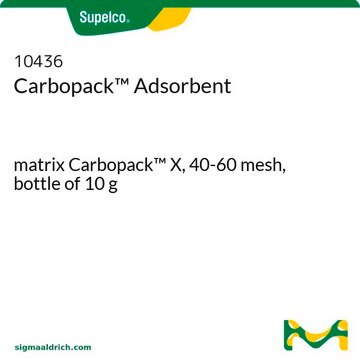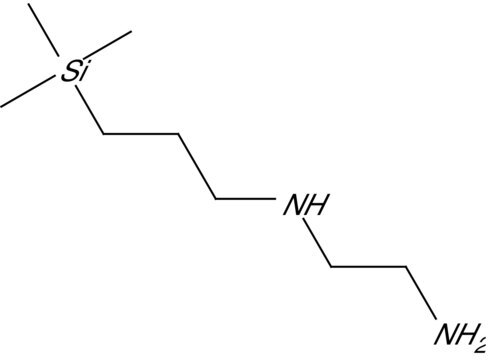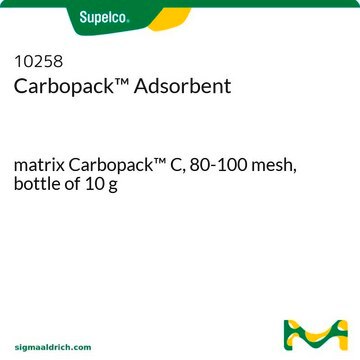11047-U
Carbotrap® Carbon Adsorbent
matrix Carbotrap® C, 20-40 mesh, bottle of 500 g
About This Item
Empfohlene Produkte
product name
Carbotrap®-Adsorbens, matrix Carbotrap® C, 20-40 mesh, bottle of 500 g
Produktlinie
Carbotrap®
Qualitätsniveau
Form
granular
Verpackung
bottle of 500 g
Methode(n)
LPLC: suitable
gas chromatography (GC): suitable
Oberflächenbereich
~10 m2/g
Matrix
Carbotrap® C
Aktive Matrixgruppe
carbon
Partikelgröße
20-40 mesh
Porengröße
~0 cm3/g macroporosity
~0 cm3/g mesoporosity
~0 cm3/g microporosity
~0 Å pore diameter
Schüttdichte
~0.70 g/mL (free fall density)
Trenntechnik
reversed phase
Suchen Sie nach ähnlichen Produkten? Aufrufen Leitfaden zum Produktvergleich
Verwandte Kategorien
Allgemeine Beschreibung
- Granulär
- Bröckelnd
- Wird verwendet für Moleküle mit einer von C3-C20+ n-Alkanen abhängigen Analytgröße
- Hydrophob (kann in Umfeldern mit hoher Luftfeuchtigkeit eingesetzt werden)
GCB-Adsorbentien bieten generell eine schwächere relative Adsorptionskraft als Kohlenstoff-Molekularsieb(CMS)-Adsorbentien und eine ähnliche relative Adsorptionskraft wie kugelförmige Adsorbentien aus graphitisierter Polymerkohle (SGPC). Unsere Carbotrap-Produkte sind eine Art von GCB-Adsorbentien.
- Teilchen haben eine Größe von 20/40 Mesh.
- Diese großen Partikeln ermöglichen hohe Durchflussraten ohne übermäßigen Druckabfall.
Weitere Informationen über unsere speziellen Kohlenstoffadsorbentien finden Sie auf www.sigma-aldrich.com/carbon
Rechtliche Hinweise
WGK
nwg
Flammpunkt (°F)
Not applicable
Flammpunkt (°C)
Not applicable
Persönliche Schutzausrüstung
Eyeshields, Gloves, type P3 (EN 143) respirator cartridges
Choose from one of the most recent versions:
Analysenzertifikate (COA)
Sorry, we don't have COAs for this product available online at this time.
If you need assistance, please contact Kundensupport
Besitzen Sie dieses Produkt bereits?
In der Dokumentenbibliothek finden Sie die Dokumentation zu den Produkten, die Sie kürzlich erworben haben.
Artikel
General guidelines for choosing carbon adsorbents, physical characteristics of Supelco® carbon adsorbents, adsorbent cross reference
Carbon Molecular sieves (CMS) are a versatile range of adsorbents that can be tailored for specific applications. Supelco® scientists have been synthesizing synthetic CMS carbons for several decades, starting from tailoring of the starting polymers/copolymers, to modifying the final properties of the subsequent CMS carbon.
Unser Team von Wissenschaftlern verfügt über Erfahrung in allen Forschungsbereichen einschließlich Life Science, Materialwissenschaften, chemischer Synthese, Chromatographie, Analytik und vielen mehr..
Setzen Sie sich mit dem technischen Dienst in Verbindung.



